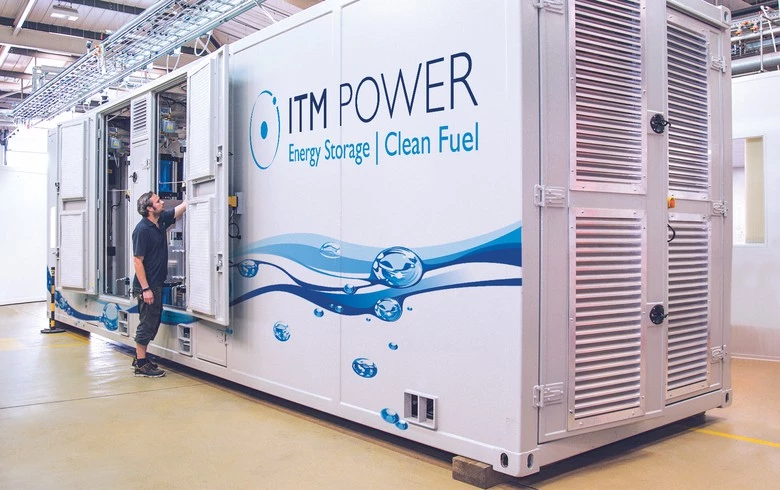
Green Hydrogen: ITM Power Signs FEED Contract for Multi-Unit NEPTUNE V Project
October 13, 2025Project in Brief
On 6 October 2025, ITM Power announced it had signed a Front-End Engineering Design (FEED) contract to supply multiple 5MW NEPTUNE V electrolysers for a green hydrogen facility shortlisted under the UK’s Hydrogen Allocation Round 2 (HAR2), managed by the Department for Energy Security & Net Zero (DESNZ). The end user is still under wraps until a Final Investment Decision (FID) comes through, but this engineering phase will map out detailed designs, cost estimates and execution plans. Subject to FID, construction will kick off, aiming for first operations in 2028. It’s all part of the UK’s net zero push, scaling up domestic hydrogen production for industrial clusters and transport applications.
Key Takeaways
- This FEED win locks in ITM Power’s NEPTUNE V units for a key UK HAR2 project.
- The plan uses multiple 5MW modules, making hydrogen production modular and driving industrial decarbonization.
- It’s all still subject to an FID, but the aim is to be up and running by 2028.
- It beefs up ITM’s pipeline after their 20MW HAR1 deal with MorGen Energy.
- CEO Dennis Schulz is pitching NEPTUNE V as a top pick for containerised, mid-scale rollouts.
- It bolsters the UK’s hydrogen infrastructure plans, even as ITM weathers some share-price turbulence.
- The spotlight’s on PEM electrolysis tech, including a nudge toward iridium-free catalysts.
- Ultimately, a solid FEED study could unlock the debt and equity needed to get this moving.
Detailed Overview
The FEED stage is where the real engineering magic happens: process flows, equipment sizing, P&IDs, civil layouts and cost models all get hashed out. ITM Power’s team will tackle system integration studies, safety reviews and the first procurement packages. The beauty of the 5MW NEPTUNE V modules is that they arrive in ISO containers—complete with pumps, compressors, control systems and safety interlocks—so once the site’s foundations, grid hookup and water supply are in place, you can have them commissioned in under six months. It’s a serious time-saver on site.
Inside each container, a PEM electrolysis stack cranks away at high current densities, splitting water into hydrogen and oxygen with efficiencies north of 70%. They can run at up to 30 bar, so you cut down on external compression. We’re not saying exactly how many modules this project will use, but it’s sized to slot perfectly into that sweet spot between pilot-scale setups and those bespoke 20MW-plus giants.
Tech Focus: NEPTUNE V Advantages
Think of NEPTUNE V as the ultimate plug-and-play: skid-mounted containers that pack the electrolyser stack, power rectifier, water purification and controls. Hooking up power, water and gas lines takes weeks, not months. Thanks to PEM electrolysis tech, they can follow loads dynamically—ramping up or down in seconds to match renewables. With over 95% uptime and operating pressures up to 30 bar, you slash auxiliary compression needs and boost efficiency. For anyone after a fast, modular approach to hydrogen production, NEPTUNE V beats both custom and alkaline alternatives hands down.
Strategic Implications
For ITM Power, locking in another FEED contract is a much-needed shot in the arm, especially after its share price took a hit over past execution delays. Nail down repeat orders in back-to-back government rounds, and you smooth out revenue visibility, prove you can handle tricky procurement—and cement NEPTUNE V as the mid-scale go-to. It screams speed, standardization and lower upfront capex, exactly what customers are looking for.
On the policy side, pushing FEED studies toward that FID milestone tells the world the UK is serious about building out its hydrogen infrastructure. That’s crucial for slashing carbon in heavy-hitting sectors like manufacturing, refining and transport. Plus, a robust pipeline of FEED-to-FID projects gives private investors confidence that green hydrogen has left the pilot phase and is gearing up for full commercial flight.
Economic and Environmental Impact
Producing green hydrogen from renewables chops lifecycle CO₂ emissions versus grey hydrogen, giving a big boost to the UK’s net-zero-by-2050 ambitions. Projects at this scale create jobs in manufacturing, construction and ops, while building out local supply chains for electrolyser parts and system integrators. The flip side? Competitiveness comes down to cheap renewable power and squeezing capex—so expect long-term PPAs and R&D into iridium-free catalysts to be game-changers.
Industry Context
The UK government is shooting for 5GW of low-carbon hydrogen capacity by 2030, channelling cash through HAR1 and HAR2 to mitigate early-stage risks. HAR1 backed those initial 5–20MW plants, teaching everyone the ropes—permitting, grid tie-ins and project finance. HAR2 then steps it up a notch, with bigger allocations and tougher technical guardrails.
Meanwhile, over on the world stage, electrolyser markets are catching fire as Europe, North America and Asia roll out their own schemes. UK players like ITM Power are eyeing exports of modular, standardised kits—think NEPTUNE V—for applications as varied as green ammonia in the Middle East or hydrogen refuelling in North America. Winning at home through HAR rounds only adds fuel to the UK’s clean-energy innovator fire.
Financing and Market Signals
Lenders and equity investors usually insist on solid FEED deliverables before they loosen the purse strings. A bankable FEED package—with crystal-clear cost models, risk assessments and execution plans—keeps project risk perceptions in check. On top of that, government-backed revenue tools, from direct grants to CfDs, provide the certainty that drives down the cost of capital. In short, landing this FEED award throws open the door to fresh financing options for ITM Power and its project partner.
Looking Ahead
All going well, we could see an FID in 2026, with shovels hitting the ground and commissioning wrapped up by 2028. Over the next 12–18 months, watch for FEED wrap-up, grid and water hookup sign-offs, and sealing up supply chain deals. The big question: can this plant—and its HAR2 siblings—sidestep the permitting and grid bottlenecks that tripped up earlier builds? If they pull it off, it’ll be a loud declaration that the UK’s hydrogen infrastructure is ready for prime time.
About ITM Power
Founded back in 2000 and trading on the AIM market of the London Stock Exchange, ITM Power is all about designing and building PEM electrolysers for green hydrogen. From its Sheffield base, the company pushes out flagship platforms like the 5MW NEPTUNE V and the 20MW POSEIDON. Under CEO Dennis Schulz, the team’s on a mission to ramp up electrolyser deployment and push forward cost-competitive, iridium-free technologies.



 With over 15 years of reporting hydrogen news, we are your premier source for the latest updates and insights in hydrogen and renewable energy.
With over 15 years of reporting hydrogen news, we are your premier source for the latest updates and insights in hydrogen and renewable energy.